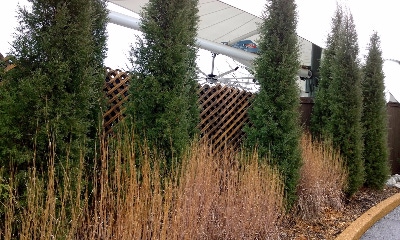August 8, 2016

In the world of gardening, evergreens rule. They screen views, define spaces, prevent erosion, cool in summer, block wind, hide birds and nests, and hold raindrops like a sponge.
Take golden ragwort (Packera aurea), for instance. It is a three-inch tall carpeting groundcover that stays green in winter and grows naturally along Ozark creeks where it holds soil. It is a great low-maintenance alternative to invasive English ivy, periwinkle, and wintercreeper, and tolerates wet soils and shade. Its cousin—round-leaved ragwort (Packera obovata)—is similar, but prefers dry soil. They both bloom yellow in April and May.

Eastern red cedar (Juniperus virginiana) is one of three evergreen trees. The other two are American holly (Ilex opaca) and shortleaf pine (Pinus echinata). All have prickly leaves and staying power. That is, they can live a long time. Cedar is known to live upwards of 1,000 years on rocky bluffs in Missouri with their branches curled and gnarled.
Eastern red cedar comes in many sizes and shapes that are sold commercially as cultivars. They are noted in single quotes like the cultivars ‘Taylor’ (tall and narrow tree like Italian cypress), ‘Glauca’ (narrow with blue-grey leaves), and ‘Canaertii’ (small pyramidal tree with dark green leaves). If you plant a seedling eastern red cedar (which lacks a cultivar name) it may mature to be skinny, fat, weeping, pyramidal, or oval in shape. Female cedars produce blue-green fruits (cones, actually) in fall and winter that are eaten by birds, especially cedar waxwings.
Shortleaf pine tends to grow tall and narrow (10 to 15 feet) in part shade and a bit wider (15 to 20 feet) in full sun. I prefer growing them in small groves since they are so narrow, but they can be grown as single specimens as well and fit well in narrow spaces. A seedling can grow to 15 feet in 5 to 7 years. The Missouri Department of Conservation tree nursery sells inexpensive bundles of 25 seedlings.
Check out the Grow Native! resource guide for a list of growers who offer native evergreens and other native plants at www.grownative.org.
Horticulturist Scott Woodbury is the Curator of the Whitmire Wildflower Garden at Shaw Nature Reserve in Gray Summit, MO, where he has worked with native plant propagation, design, and education for more than 20 years. He also is an advisor to the Missouri Prairie Foundation’s Grow Native! program.
You May Also Like




